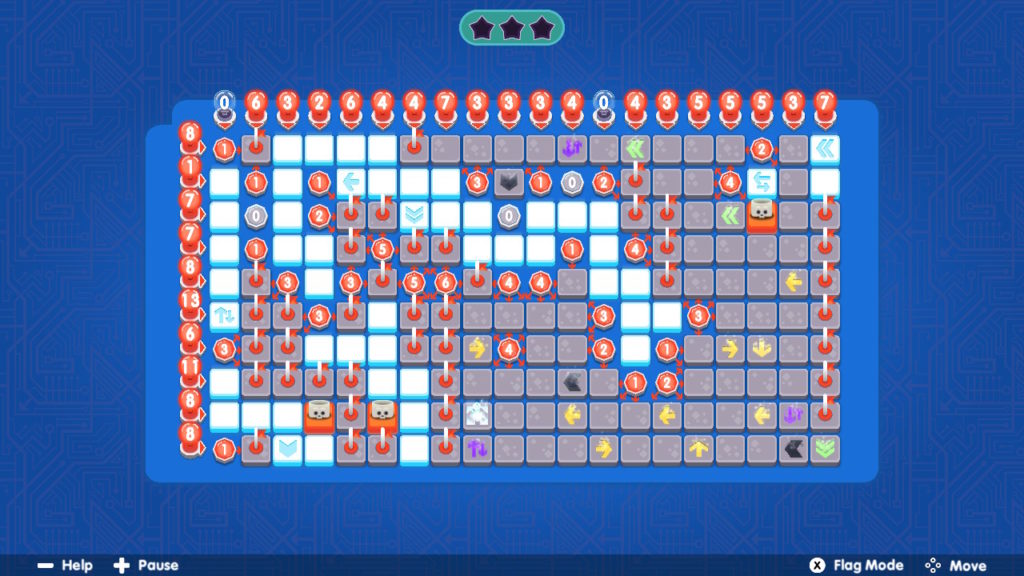2019 has already been a terrific year for unique picross games. Pic-a-Pix Pieces released right at the beginning of the year, which turned the standard Pic-a-Pix Deluxe puzzles into numerous individual pieces of one large image. Then Piczle Colors came along at the end of January, turning the standard picross clue format on its head. But now, halfway through February, Blowfish Studios has created the most unique picross-like game I’ve ever played: Minesweeper Genius.

Minesweeper Genius is an amalgamation of picross and Minesweeper with a dash of tension thrown in. You’re shown the number of mines in each row and column, and your goal is to safely guide Aristotle to the exit portal. There is exactly one path in each procedurally-generated maze that doesn’t lead to death, and a single step off of that path in any direction will blow you up. Luckily, Aristotle can respawn twice, but if he dies three times, it’s game over!
The game plays simply enough but is very difficult to master. You’re shown the total number of mines at the bottom of the screen, and you can place flags to warn yourself about where they are at any time. You can also move Aristotle around freely, although randomly pressing a cardinal direction has a 50-75% mortality rate. All of the harder puzzles had me flipping between placing obvious flags, moving a bit, narrowing down my options for my next move, moving again, and so on. Because you actually move Aristotle around, there’s a solid amount of tension with each move, especially toward the end of a puzzle or after messing up a couple times.
As if moving around a maze full of hidden explosives wasn’t enough, the game also has all sorts of squares that shift the puzzle around. You might jump over a square with one, and then shift a whole row or column before swapping one column or row with another. These squares are a bit of a reprieve, really, since you’ll always know to step on one if you’re beside one. But if you’re in a puzzle with lots of these types of spaces, it’s harder to narrow down potential paths in front of you as the layout will shift repeatedly.

I really loved this new take on picross, and the campaign kept me busy for a good 8-10 hours before I earned three stars on each level. You lose a star for each death, and if you restart the level you’ll get a new randomly-generated level, so it’s not like you can just memorize a level and fly through it to get three stars. The main levels are rather easy, but they’re a great way to learn the game, and if you get 3 stars on all 10 levels you’ll almost always unlock some extra difficult levels as well. These are a real challenge, and I ended up resetting more than half of them at least once to earn the full three stars on them. The later areas really had me sweating as I moved Aristotle around the map, double-checking that I wasn’t missing anything and causing him to explode mere steps away from the exit.

Once you’re done with the campaign, or for those who want custom challenges, there’s an option to have a level generated to your own specifications. Players can customize the puzzle size, the number of mines, and the number of special blocks. There’s also the option to randomize all of these settings, which is my favorite option. With that said, though, it’s rather crazy playing a puzzle with the maximum amount of spaces, mines, and special blocks, or with no special blocks at all like a purist.
The sound effects add to the tension too. There’s a nice little note progression as you walk from one space to the next, and hearing that high-pitched “boop” every step felt like when I’d hear the Super Mario Bros. or Tetris music escalate when things got risky. Aside from that, the art and sound effects are super cute. The cuteness blended with the nervousness of knowing that I’m almost always one step away from death is a really wild combination, but it works well.

There are LOTS of things going on in Minesweeper Genius, but it’s always as simple as dodging mines.
While I enjoyed almost everything about the game, there were two major flaws with the UI: there’s no way to mark a row or column as complete, and there’s no way to mark a space as safe. On the bigger levels, it’s easy to get mixed up without either of those options, and I even had to bust out a notepad on the more challenging puzzles when I was trying to get three stars.
The only other issue I had with Minesweeper Genius was finding a reason to keep playing. Once the campaign is done, the only reason to continue playing is for fun. It sounds silly to say that since the entire point of the game is to have fun, but I would’ve loved to earn some kind of in-game currency after each puzzle that could be used to customize the game. Unlocking more random level options, some cute outfits, or some other types of options would’ve been awesome, but I understand that not everyone needs that kind of stuff.

When all is said and done, a non-sale price of $6 is amazing for the amount of polish and content in the game. Puzzle lovers, especially those who love other picross-style games, shouldn’t hesitate to grab a copy on their favorite console.
Minesweeper Genius is available on Nintendo Switch (reviewed), Xbox One, PlayStation 4, iOS, and from the Google Play store.
A review code was provided for this review.

